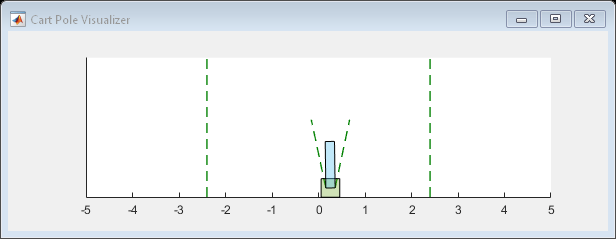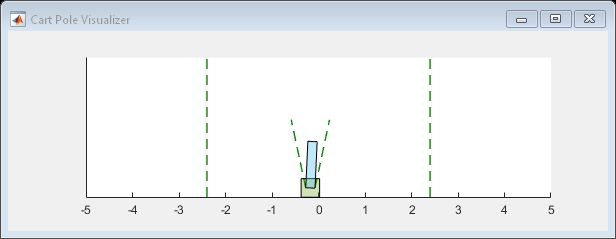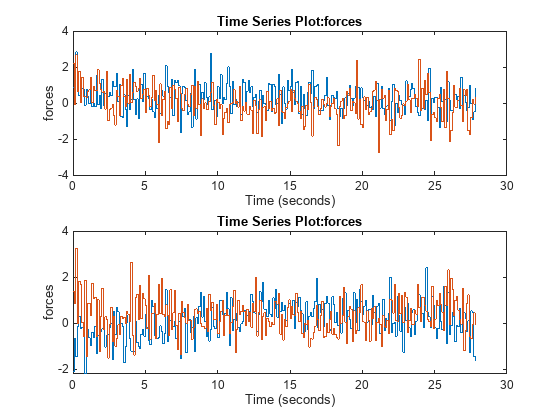sim
Simulate trained reinforcement learning agents within specified environment
Description
experience = sim(env,agents)
experience = sim(agents,env)
Examples
Simulate a reinforcement learning environment with an agent configured for that environment. For this example, load an environment and agent that are already configured. The environment is a discrete cart-pole environment created with rlPredefinedEnv. The agent is a policy gradient (rlPGAgent) agent. For more information about the environment and agent used in this example, see Train PG Agent to Balance Discrete Cart-Pole System.
rng(0) % for reproducibility load RLSimExample.mat env
env =
CartPoleDiscreteAction with properties:
Gravity: 9.8000
MassCart: 1
MassPole: 0.1000
Length: 0.5000
MaxForce: 10
Ts: 0.0200
ThetaThresholdRadians: 0.2094
XThreshold: 2.4000
RewardForNotFalling: 1
PenaltyForFalling: -5
State: [4×1 double]
agent
agent =
rlPGAgent with properties:
AgentOptions: [1×1 rl.option.rlPGAgentOptions]
UseExplorationPolicy: 1
ObservationInfo: [1×1 rl.util.rlNumericSpec]
ActionInfo: [1×1 rl.util.rlFiniteSetSpec]
SampleTime: 0.1000
Typically, you train the agent using train and simulate the environment to test the performance of the trained agent. For this example, simulate the environment using the agent you loaded. Configure simulation options, specifying that the simulation run for 100 steps.
simOpts = rlSimulationOptions(MaxSteps=100);
For the predefined cart-pole environment used in this example, you can use plot to generate a visualization of the cart-pole system. When you simulate the environment, this plot updates automatically so that you can watch the system evolve during the simulation.
plot(env)

Simulate the environment.
experience = sim(env,agent,simOpts)

experience = struct with fields:
Observation: [1×1 struct]
Action: [1×1 struct]
Reward: [1×1 timeseries]
IsDone: [1×1 timeseries]
SimulationInfo: [1×1 rl.storage.SimulationStorage]
The output structure experience records the observations collected from the environment, the action and reward, and other data collected during the simulation. Each field contains a timeseries object or a structure of timeseries data objects. For instance, experience.Action is a timeseries containing the action imposed on the cart-pole system by the agent at each step of the simulation.
experience.Action
ans = struct with fields:
CartPoleAction: [1×1 timeseries]
Simulate an environment created for the Simulink® model used in the Train Multiple Agents to Perform Collaborative Task example.
Load the file containing the agents. For this example, load the agents that have been already trained using decentralized learning.
load decentralizedAgents.matCreate an environment for the rlCollaborativeTask Simulink model, which has two agent blocks. Since the agents used by the two blocks (agentA and agentB) are already in the workspace, you do not need to pass their observation and action specifications to create the environment.
env = rlSimulinkEnv( ... "rlCollaborativeTask", ... ["rlCollaborativeTask/Agent A","rlCollaborativeTask/Agent B"]);
It is good practice to specify a reset function for the environment such that agents start from random initial positions at the beginning of each episode. For an example, see the resetRobots function defined in Train Multiple Agents to Perform Collaborative Task. For this example, however, do not define a reset function.
Load the parameters that are needed by the rlCollaborativeTask Simulink model to run.
rlCollaborativeTaskParams
Simulate the agents against the environment, saving the experiences in xpr.
xpr = sim(env,[dcAgentA dcAgentB]);
Plot actions of both agents.
subplot(2,1,1); plot(xpr(1).Action.forces) subplot(2,1,2); plot(xpr(2).Action.forces)

Input Arguments
Environment in which the agents act, specified as one of the following kinds of reinforcement learning environment object:
A predefined MATLAB® or Simulink® environment created using
rlPredefinedEnv.A custom MATLAB environment you create with functions such as
rlFunctionEnvorrlCreateEnvTemplate. This kind of environment does not support training multiple agents at the same time.A Simulink environment you create using
createIntegratedEnv. This kind of environment does not support training multiple agents at the same time.A custom Simulink environment you create using
rlSimulinkEnv. This kind of environment supports training multiple agents at the same time, and allows you to use multi-rate execution, so that each agent has its own execution rate.A custom MATLAB environment you create using
rlMultiAgentFunctionEnvorrlTurnBasedFunctionEnv. This kind of environment supports training multiple agents at the same time. In anrlMultiAgentFunctionEnvenvironment all agents execute in the same step, while in anrlMultiAgentFunctionEnvenvironment agents execute in turns.
For more information about creating and configuring environments, see:
When env is a Simulink environment, the environment object acts an interface so that
sim calls the (compiled) Simulink model to generate experiences for the agents.
Agents to simulate, specified as a reinforcement learning agent object, such as
rlACAgent or
rlDDPGAgent, or
as an array of such objects.
If env is a multi-agent environment, specify agents as an
array. The order of the agents in the array must match the agent order used to create
env.
For more information about how to create and configure agents for reinforcement learning, see Reinforcement Learning Agents.
Simulation options, specified as an rlSimulationOptions object. Use this argument to specify options such
as:
Number of steps per simulation
Number of simulations to run
For details, see rlSimulationOptions.
Output Arguments
Simulation results, returned as a structure or structure array. The number of rows
in the array is equal to the number of simulations specified by the
NumSimulations option of rlSimulationOptions.
The number of columns in the array is the number of agents. The fields of each
experience structure are as follows.
Observations collected from the environment, returned as a structure with
fields corresponding to the observations specified in the environment. Each field
contains a timeseries of length
N + 1, where N is the number of simulation
steps.
To obtain the current observation and the next observation for a given
simulation step, use code such as the following, assuming one of the fields of
Observation is obs1. For more
information, see getsamples.
Obs = getsamples(experience.Observation.obs1,1:N); NextObs = getsamples(experience.Observation.obs1,2:N+1);
sim to generate experiences for training.Actions computed by the agent, returned as a structure with fields
corresponding to the action signals specified in the environment. Each field
contains a timeseries of length
N, where N is the number of simulation
steps.
Reward at each step in the simulation, returned as a timeseries of length
N, where N is the number of simulation
steps.
Flag indicating termination of the episode, returned as a timeseries of a scalar logical
signal. This flag is set at each step by the environment, according to conditions
you specify for episode termination when you configure the environment. When the
environment sets this flag to 1, simulation terminates.
Environment simulation information, returned as:
An
SimulationStorageobject, ifSimulationStorageTypeis set to"memory"or"file".An empty array, if
SimulationStorageTypeis set to"none".
A SimulationStorage object contains environment information collected
during simulation, which you can access by indexing into the object using the episode
number.
For example, if res is an rlTrainingResult object
returned by train, or an experience structure
returned by sim, you can access the environment simulation
information related to the second episode as:
mySimInfo2 = res.SimulationInfo(2);
For MATLAB environments,
mySimInfo2is a structure containing the fieldSimulationError. This structure contains any errors that occurred during simulation for the second episode.For Simulink environments,
mySimInfo2is aSimulink.SimulationOutputobject containing logged data from the Simulink model. Properties of this object include any signals and states that the model is configured to log, simulation metadata, and any errors that occurred during the second episode.
A SimulationStorage object also has the following read-only
properties:
Total number of episodes ran in the entire training or simulation, returned as a positive integer.
Example: 2670
Type of storage for the environment data, returned as either
"memory" (indicating that data is stored in memory)
or "file" (indicating that data is stored on disk). For
more information, see the SimulationStorageType
property of rlEvolutionStrategyTrainingOptions and Address Memory Issues During Training.
Example: "file"
Version History
Introduced in R2019a
See Also
Functions
Objects
MATLAB Command
You clicked a link that corresponds to this MATLAB command:
Run the command by entering it in the MATLAB Command Window. Web browsers do not support MATLAB commands.
选择网站
选择网站以获取翻译的可用内容,以及查看当地活动和优惠。根据您的位置,我们建议您选择:。
您也可以从以下列表中选择网站:
如何获得最佳网站性能
选择中国网站(中文或英文)以获得最佳网站性能。其他 MathWorks 国家/地区网站并未针对您所在位置的访问进行优化。
美洲
- América Latina (Español)
- Canada (English)
- United States (English)
欧洲
- Belgium (English)
- Denmark (English)
- Deutschland (Deutsch)
- España (Español)
- Finland (English)
- France (Français)
- Ireland (English)
- Italia (Italiano)
- Luxembourg (English)
- Netherlands (English)
- Norway (English)
- Österreich (Deutsch)
- Portugal (English)
- Sweden (English)
- Switzerland
- United Kingdom (English)